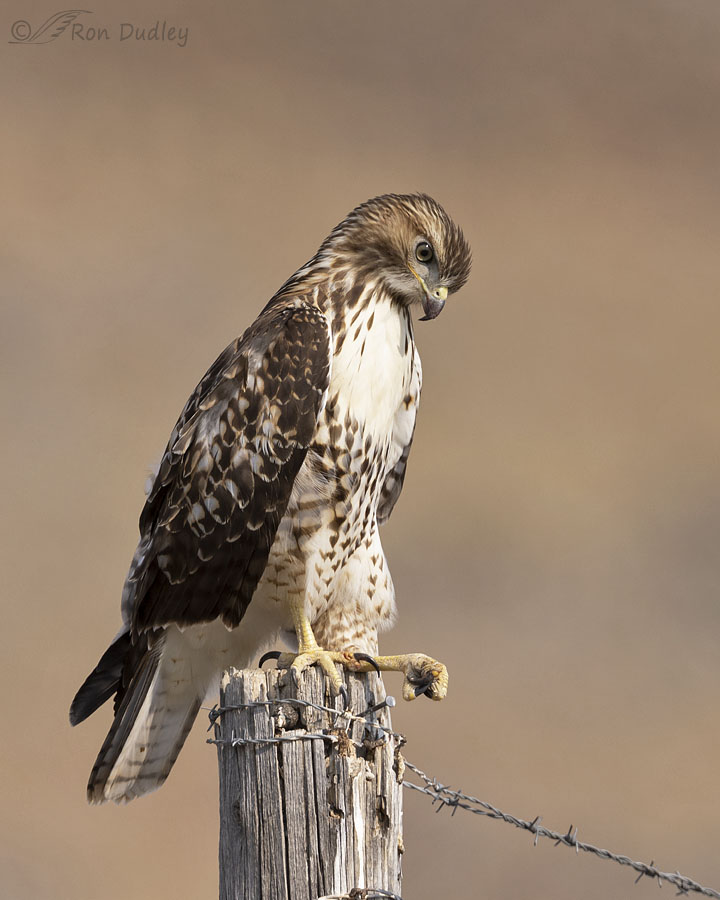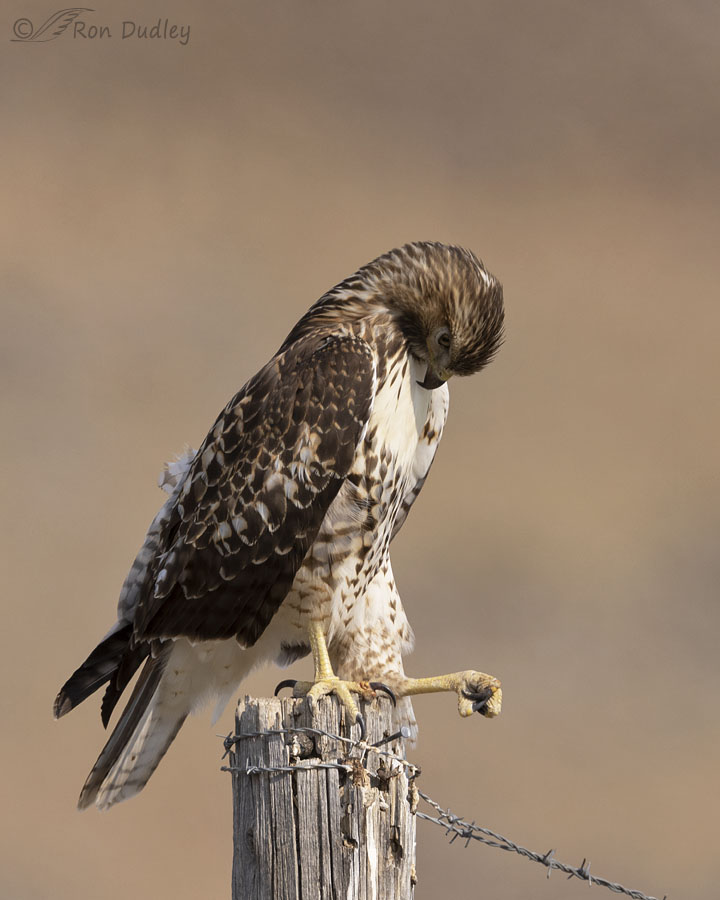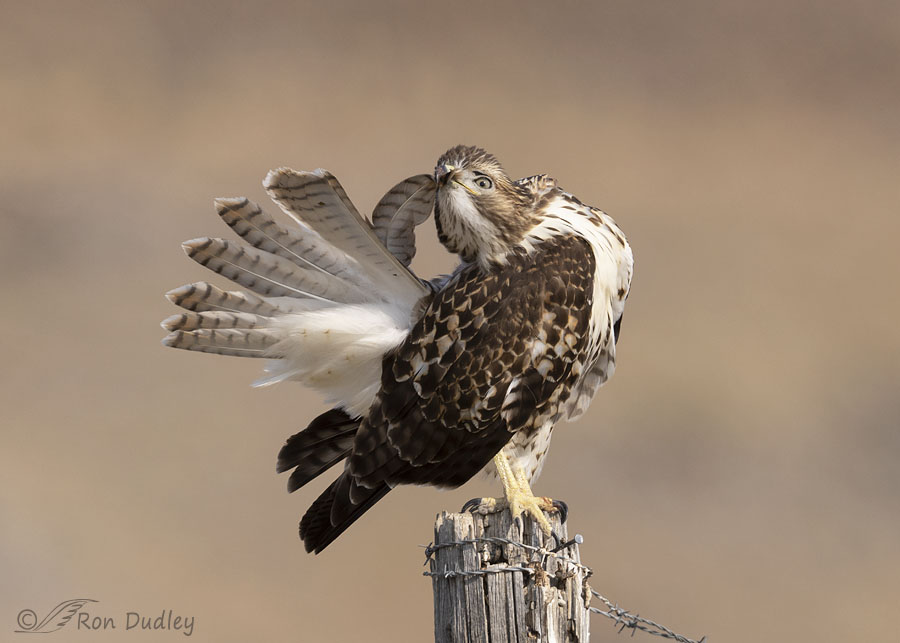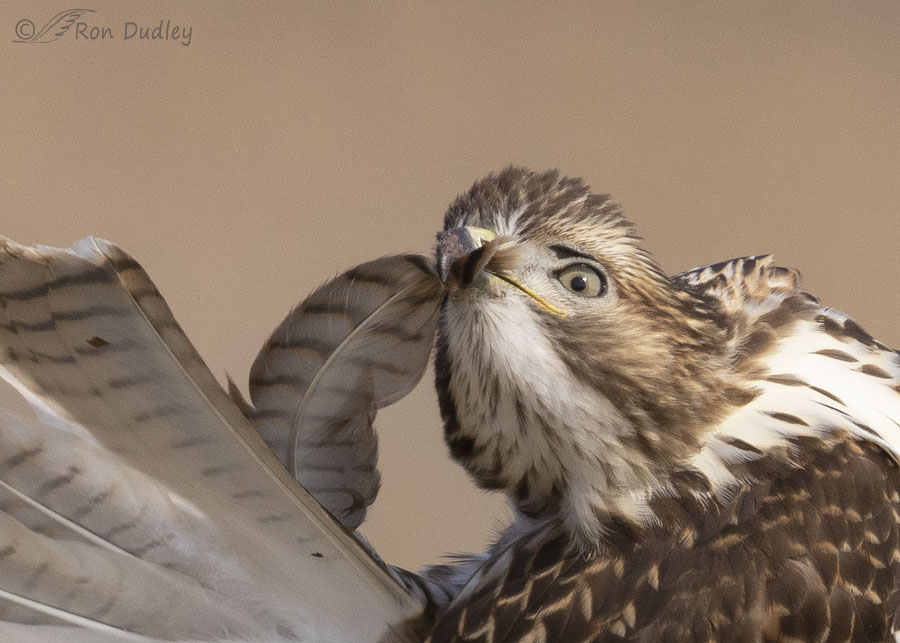It’s the time of year for young red-tails acting goofy.

1/3200, f/6.3, ISO 500, Canon R5, Canon EF500mm f/4L IS II USM + 1.4 tc, not baited, set up or called in
Four days ago I spent 18 minutes up close with this juvenile Red-tailed Hawk on a gnarly old fence post as ‘he’ preened and posed for me in pretty good light. This pose, with one leg and clenched foot sticking way out, is fairly common for red-tails but what made this young bird different and amusing was his reaction to his own appendage.
He was fascinated by it, as if he was just discovering that it belonged to him. He kept staring at it, intensely, as he moved it further away from his body and then pulled it back in. And he did it repeatedly, with his eyes glued to that leg and clenched foot the entire time. He reminded me of a human baby discovering parts of his or her own body.
If you don’t think he’s staring at his leg and foot…

1/3200, f/6.3, ISO 500, Canon R5, Canon EF500mm f/4L IS II USM + 1.4 tc, not baited, set up or called in
check this out.
This is the angle he usually had his head at as he focused on that strange appendage down there. The head angle didn’t allow for light on his face or in his eye but it certainly demonstrated how fascinated he was by a part of his body that he apparently was just realizing belonged to him.

1/3200, f/6.3, ISO 500, Canon R5, Canon EF500mm f/4L IS II USM + 1.4 tc, not baited, set up or called in
This is probably my favorite preening pose of raptors, or of any bird really, but it’s incredibly difficult to get their eye open when they do it (usually it’s closed to protect it.). He was ‘rezipping’ the hooks on each individual tail feather so I took dozens of photos while he was in this general pose with different tail feathers in his bill. But I only got two shots with his eye open and the two photos were identical to each other.
At first glance I couldn’t quite figure out what was going on with his bill in this photo. It looks different somehow.

It turns out that he had a clump of dirt/mud on his bill that I hadn’t noticed before and that brighter yellow-white spot above it was just his cere. My original impression of his bill was further distorted by the very tip of the tail feather that he’s pulling through his bill.
I’m sure glad I can crop in heavily on photos like this and get more detail. If I couldn’t my curiosity would kill me.
Ron


Beautiful photos, I love them all! Catching up today, yesterday was busy with releases.
I love the “what is that” look! I had the pleasure of seeing a baby discover her hands for the first time. It was a delight! Glad you had so much fun with this youngster.
“I love the “what is that” look! I had the pleasure of seeing a baby discover her hands for the first time.”
Arwen, I remember daughter Shannon discovering her feet.
I can only imagine the prude and humor in that moment. 🙂
What a awonderful series!
Charlotte Norton
Thanks, Charlotte.
What a fun 18 minutes! Reminds me of fostering puppies and kittens as they figure out what appendages are theirs (vs. their litter-mates’) and how to control them. Thank you for sharing these delightful shots! 🙂
Glad you enjoyed them, Marty. Thanks.
Another truly delightful series.
And I do hope that the youngster is/was impressed with his discovery. He should be.
“He should be”
No kidding, EC. In his ‘shoes” I sure would be.
Red-tailed delight! And as much as I appreciate all of these photos, each with their attendant virtues, that first one really captures my heart. Such a sweet and curious face to go with a perfect, beautiful body, Mother Nature’s work of art. And on my birthday — it can’t get much better than that! So even though you had no idea, thanks, Mr. D, for this special gift. 🥳 ♥️
Well, Happy Birthday, Chris! I hope you have a great one.
Oh, yeah. The ‘what is that’ look and the ‘lightbulb’ look on the faces of (mostly) young animals, birds and even humans is worth its weight in gold and, for me, produce some of my strongest and best memories of times, places and actors. It must have been a chortle worthy delight to watch this tyoungster. And I’m very happy hard crops can satisfy your curiosity because that provides a similar ‘aha’ moment for all of us. Gorgeous light and colours and fun poses and behaviour and some curiosity satisfied is a great way to start the morning.
I find this young birds actions to be very heart warming.
Take Care,
Kaye
As do I.
Definitely one of the best preening photos I have seen. Have taken hundreds myself of various birds and raptors, but never quite that interesting. Very interesting and well photographed series. Thanks too for the CERE. Did not know there was a name for that area.
Also agree with Michael’s observations of the reaction of other birds to an immature raptor. I too have observed that behavior. They definitely know who is a pro and who is a rookie.
Everett, I’ve known about the cere for longer than I’ve known most other things about bird anatomy. I first learned about it when I raised pigeons when I was a pre-teenager.
Who knew a bird of prey could be such a cutup? That had to have been a very amusing 18 minutes.
Could it also be that he is comparing his claws to the barbed wire?
The feet apparently are functioning well because, similar to yesterday’s photo this juvenile appears to have signs of a previous meal on his toe.
Preening and saluting. What a ham.
That 18 minutes was fun, Lyle. A very cooperative and trusting young red-tail.
Cere, nares, lores–good bird anatomy lesson this morning ! Wonder how long I can retain these words ? Fun to learn them, and what they represent.
Kris, I thought it was interesting that we STILL don’t know the function of the cere. Or understand why some birds have them and others don’t.
Neat series, Ron. Funny that juvenille birds also have to “discover” parts of their body….. 😉 It IS nice to be able to get a good crop to check out smaller detail. 🙂
58 this morning – MUCH more reasonable than the 78 of yesterday morning. 🙂
It was cooler here this morning too, Judy. I saw 62° for a few minutes on the island this morning. A little, very little, rain last night helped to cool things down.
Sweet and majestic at the same time. And thanks for the link to cere – helpful.
Frances, then I’m glad I included the link. I need to remember to do that more often, when it seems appropriate.
Another great behavioral series. Love it!
To me, that ruddy bit on the bill appears to be a dried leftover from a meal.
You can tell if a hawk is an adult or juvenile just by the way they act. I believe other birds can do so as well. An interesting thing that I have observed is that mockingbirds in our neighborhood seem to know when a Coopers they encounter is immature, as they seem more confident in their protective behaviors. Mockingbirds will come in close to screech at a perched juvenile, and will closely chase and attack the young coops in flight for quite a distance. I don’t see that level of interaction (if any at all) with adult coops. Perhaps some of this has to do with the adults being more stealthy and the juveniles being so “goofy”.
Michael, I have no doubt that at least some birds can distinguish young raptors from more experienced adults – especially when the raptors are accipiters.